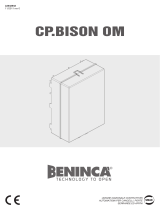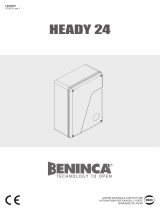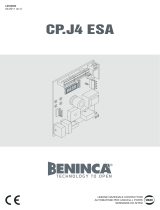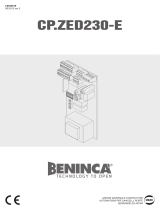Page is loading ...

L8542876
02/2013 rev 2
CP.BN
UNIONE NAZIONALE COSTRUTTORI
AUTOMATISMI PER CANCELLI, PORTE
SERRANDE ED AFFINI

2
LAMP
24Vdc
M1
M2
RADIO
F4
LED2
T 1,6A
ANT
3
91011121314
171819202122
BN.CB
232425
262728
1 2
4
PHOT
PHOT C
STOP
P.P.
PED
COM
24Vdc/0,5Amax
-M1+M1
-M1+M1
N
L
F2:1AT (230V)
F2:2AT (115V)
+ -
1

3
B N. 2 4 V
C P.B N
MINV:ON
MINV:OFF
M 1
M 2
M 1
M 2
F1
F10A
-
+
1 2 V
B N . 2 4 V
1 2 V
3
2
L N
Service
Light
230V
Relè 24Vdc
SCA 24Vdc
3W max
2ch:ON
910111213141516
24Vdc/0,5Amax
2ch:Off
serl:Off
910111213141516 910111213141516
2ch:Off
serl:on
4

11
WARNINGS
This manual has been especially written to be use by
qualified fitters.
None of the information provide in this manual can be
considered as being of interest for the end users.
Preserve this manual for future needs.
The technician has to furnish all the information related to
the step by step function, the manual and the emergency
function of the operator, and to deliver the manual to the
final user.
c
Foresee on the supply net an onnipolar switch or
selector with distance of the contacts equal or
superior to 3 mms.
Verify that of the electrical system there is an awry diffe-
rential interrupter and overcurrent protection.
Some typologies of installation require the connection of
the shutter to be link at a conductive mass of the ground
according to the regulations in force.
The electrical installation and the operating logic must
comply with the regulations in force.
The leads fed with different voltages must be physically
separate, or they must be suitably insulated with additional
insulation of at least 1 mm.
The leads must be secured with an additional fixture near
the terminals.
During installation, maintenance and repair, interrupt the
power supply before opening the lid to access the electri-
cal parts
Check all the connections again before switching on the
power.
The unused N.C. inputs must be bridged.
The descriptions and the present illustrations in this manual
are not binding. Leaving the essential characteristics of
the product unchanged, the manufacturer reserves himself
the right to bring any change of technical, constructive
or commercial character without undertaking himself to
update the present publication.
EC Declaration of conformity
Declaration pursuant to Directives 2004/108/EC(EMC); 2006/95/EC(LVD)
Manufacturer:
Automatismi Benincà SpA
Address:
Via Capitello, 45 - 36066 Sandrigo (VI) - Italy
Declares that the product:
Command central for 1/2 230 Vac motor, for single: CP.BN
is compliant with the conditions of the following EC Directives:
• DIRECTIVE 2004/108/EC OF THE EUROPEAN PARLIAMENT AND COUNCIL of December 15 2004 regarding
the approximation of the legislations of the member States relative to electromagnetic compatibility and that repeals directive
89/336/CEE, according to the following concurred norms:
EN 61000-6-2:2005, EN 61000-6-3:2007.
• DIRECTIVE 2006/95/EC OF THE EUROPEAN PARLIAMENT AND THE COUNCIL of December 12 2006 concer-
ning the approximation of the legislations of the member States relative to electrical material destined to be used within certain
voltage limits, according to the following concurred regulations:
EN 60335-1:2002 + A1:2004 + A11:2004 + A12:2006 + A2:2006 + A13:2008; EN 60335-2-103:2003.
if applicable :
• DIRECTIVE 1999/5/EC OF THE EUROPEAN PARLIAMENT AND THE COUNCIL of March 9 1999 regarding radio
devices and terminal and telecommunications devices and the reciprocal recognisances of their conformity, according to the
following concurred regulations: ETSI EN 301 489-3 V1.4.1 (2002) + ETSI EN 301 489-1 V1.4.1 (2002) + ETSI EN 300 220-3
V1.1.1 (2000) + EN 60950-1 (2001)
Benincà Luigi, Legal manager.
Sandrigo, 02/11/2010.

12
CP.BEN CONTROL UNIT
WIRE DIAGRAM
Wire connections shown in Fig. 1 are described hereunder:
Terminal
no.
Function Description
1-2 24Vac/dc Input, power supply, 24Vac/24Vdc.
3-4 Antenna Connection to insertable radio-receiver card antenna (3-screen/4-signal).
9-10 SCA/SRL/2° Ch
Radio
Volt-free contact, Normally Open, controlled by logics “2° Ch Radio” (2
nd
Radio channel)
and “SRL”.
With “2
nd
Radio channel” logics On: active output as 2
nd
Radio channel.
With “2
nd
Radio channel” logics Off:
- With “SRL” logics On: Contact for courtesy light control
- With “SRL” logics Off: Contact for “SCA” open gate light
11-12 24 Vdc Output, accessories power supply, 24Vc/0.5A max (12+/11-).
13-14 Flashing light Connection of warning flashing light, 24Vdc 15W max.
17 PED/CLOSE With “OPEN/CLOSE” logics Off: Input, pedestrian push-button (Normally Open contact). It
controls motor 1 opening.
With “OPEN/CLOSE” logics On: Input, close push-button (Normally Open contact). It
controls both motors.
18 Step-by-Step/OPEN With “OPEN/CLOSE” logics Off: Input, step-by-step push-button (Normally Open contact).
With “OPEN/CLOSE” logics On: Input, OPEN push-button (Normally Open contact). It
controls the opening of both motors.
19 PHOT C Input, photocell is activated only during closure (Normally Closed contact Normally Closed
contact)
20 PHOT Input, photocell is activated during opening and closing (Normally Closed contact)
21 STOP Input, STOP push-button (Normally Closed contact)
22 COM Common for all control inputs.
23-25 Motor 1 Pre-wired rapid connector, motor 1
24 Motor 1, Ground Ground of motor 1
26-28 Motor 2 Extractable connector for connection of motor 2: 24Vdc 120W max
27 Motor 2, Ground Ground of motor 2
BN.CB Buffer battery Rapid connector for connection of battery charger card BN.CB
TO CHECK CONNECTIONS
1) Cut off power supply.
2) Manually release the gate leaves, move them to around half their stroke and block them again.
3) Restore power supply.
4) Send a sep-by-step control by using the push-button connected to the Input, Step-by-Step (PP), radio control or push-button <->.
TECHNICAL DATA
Contol unit supply
24 Vdc
Power supply
230 Vac 50/60 Hz or 115Vac 50/60Hz according to the version
Output supply
1/2 motor 24Vdc
Power maximum motor
120/120 W
Output supply accessories
24Vdc 500mA max.
Protection level
IP44
Operating temp.
-20°C / +50°C
Radio receiver
built in 433,92 MHz confgurabile (rolling-code or programmable + rolling-code)
Rolling code transmitters supported
64

13
5) The gate leaves should open.
In the negative, the operation wires of the motor should be inverted by turning motor 1 connector by 180° and inverting wires
26<>28 for motor M2.
6) Select the motor which should start the operation first in the opening phase by using the MINV logics, see Fig.4.
7) Carry out an autoset procedure (see SET menu).
PROGRAMMING
The programming of the various functions of the control unit is carried out using the LCD display on the control unit and setting the
desired values in the programming menus described below.
The parameters menu allows you to assign a numerical value to a function, in the same way as a regulating trimmer.
The logic menu allows you to activate or deactivate a function, in the same way as setting a dip-switch.
Other special functions follow the parameters and logic menus and may vary depending on the type of control unit or the software
release.
USE OF PROGRAMMING KEYS
Press <PG> key to gain access to the Main Menu (PAR>>LOG>>RADIO>>...). These keys can be selected by pressing + and
– keys.
Select the Main menu with <PG> key to enter the desired Function Menu .
• If <+> is pressed, the Function Menu can be scrolled from top to bottom.
• If <-> is pressed, the Function Menu can be scrolled from bottom to top.
• If <PG> key is pressed, presetting to be modified can be entered.
• The preset values can be modified by using <+> and <-> keys.
• The value is programmed if <PG> key is pressed again. The word “PRG” appears on the display.
See paragraph “Programming Example”.
NOTES:
Simultaneously pressing <+> and <-> from inside a function menu allows you to return to the previous menu without making any
changes.
Hold down the <+> key or the <-> key to accelerate the increase/decrease of the values.
After waiting 30s the control unit quits programming mode and switches off the display.
Pressing <-> with the display turned off means an impulse of P.P.
PARAMETERS, LOGIC AND SPECIAL FUNCTIONS
The tables below describe the individual functions available in the control unit.
MENU FUNCTION
MIN-MAX-(Default)
MEMO
PARAMETERS
TCA
Automatic closing time. Active only with logic “TCA”=ON.
At the end of the set time the control unit orders a closing manoeuvre.
1-240-(40s)
tsm1
Braking value of motor 1. The values indicate the brake percentage of
the gate leaf (25%-50%-75%-100%) compared to the total opening/
closing.
25-100-(50)
tsm2
Braking value of motor 2. The values indicate the braking percentage
of the gate leaf (25%-50%-75%-100%) compared to the total opening/
closing.
25-100-(50)
TPED
Operating time of pedestrian gate leaf
Values which can be preset are:
25: 25% opening
50: 50% opening
100: 100% opening
25-100-(100)
PMo1
The torque applied to motor 1 during the opening phase is adjusted.* 1-99-(20%)
PMC1
The torque applied to motor 1 during the closing phase is adjusted.* 1-99-(20%)
PMo2
The torque applied to motor 2 during the opening phase is adjusted.* 1-99-(20%)
PMc2
The torque applied to motor 2 during the closing phase is adjusted.* 1-99-(20%)
TDMo
Mot.2 opening delay time.
Regulates the delay time of motor 2 on opening with respect to motor 1
0-15-(2s)
TDMC
Mot.1 closing delay time
Regulates the delay time of motor 1 on closing with respect to motor 2
0-40-(3s)
SLD1
It regulates the motor 1 speed during braking. The value is expressed in
percentage with respect to normal operating speed.
40-99 (50)
SLD2
It regulates the motor 2 speed during braking. The value is expressed in
percentage with respect to normal operating speed.
40-99 (50)

14
PARAMETERS
Pso1
The torque applied to motor 1 during braking in the opening phase is ad-
justed *
1-99-(20%)
Psc1
The torque applied to motor 1 during braking in the closing phase is ad-
justed *
1-99-(20%)
Pso2
The torque applied to motor 2 during braking in the opening phase is ad-
justed *
1-99-(20%)
Psc2
The torque applied to motor 2 during braking in the closing phase is ad-
justed *
1-99-(20%)
TLS
It adjusts the operating time of the service light when the “Service Light”
logics is preset to ON and the “2nd radio channel” logics is preset to
OFF
2s-180s-(60s)
* WARNING: An incorrect setting of these parameters may result in an hazard. Comply with regulations in force!
To check the torque applied to the various phases of the operation, proceed as follows:
With switched-off display and moving gate leaves, press and keep the <+> key pressed
Two figures separated by a dot are displayed (e.g. 52.55), the first two figures indicate the torque applied to motor 1, while the
last two the torque applied to motor 2.
MENU FUNCTION
ON-OFF-(Default)
MEMO
LOGIC
TCA
Enables or disables automatic closing
On: automatic closing enabled
Off: automatic closing disabled
(ON)
IbL
Enables or disables condominium function.
On: condominium function enabled. The step-by-step impulse or transmitter
impulse has no effect during the opening phase.
Off: condominium function disabled.
(OFF)
SCL
Enables or disables rapid closing
On: rapid closing enabled. With the gate open or in the opening phase the
intervention of the photocell causes automatic closing after 3 s. Active only
with TCA:ON.
Off: rapid closing disabled.
(OFF)
PP
Selects the operating mode of the ”Step by step button” and of the
transmitter.
On: Operation: OPEN > CLOSE > OPEN >
Off: Operation: OPEN > STOP > CLOSE > STOP >
(OFF)
PRE
Enables or disables pre-blinking.
On: Pre-blinking enabled. Blinking is activated 3s before the motor starts.
Off: Pre-blinking disabled.
(OFF)
SERL
The “service light” function is enabled or disabled on terminals (9-10)
On: output, enabled as “Service light”. This output is activated at the beginning
of each operation and remains activated for the time preset by parameter TLS.
Off: output, enabled as “Open gate light”.
This function is not enabled if the “2°Ch radio” logics is preset to ON.
OFF
2ch
The second radio channel is enabled or disabled on terminals (9-10).
On: “2
nd
radio channel” output is enabled.
Off: “2
nd
radio channel” output is disabled. The output to terminals is activated
as “Service light” if SERL=On, or as SCA if SERL=Off.
If this function is preset to On, any presetting of the SERL logics will be ig-
nored.
(OFF)
CLOC
The OPEN Input mode is preset.
On: OPEN Input, with CLOCK function.
To be used as connection to timer for timed opening/closing. (Closed contact:
gate open. Open contact: normal operation).
Off: OPEN input, with OPEN function.
This function is activated only if the OPCL logics=ON
(OFF)
OPCL
The Step-by-Step and Pedestrian input modes is selected.
On: Input to terminal 18 activated as OPEN. Input to terminal 17 is activated
as Closed.
Off: Input to terminal 18 activated as Step-by-Step. Input to terminal 17 acti-
vated as Pedestrian.
(OFF)

15
LOGIC
INVC
The total reverse movement is enabled or disabled when the amperometric
sensor is triggered.
On: total reversion is enabled
Off: total reversion is disabled. The control unit controls a 2sec reversion and
then locks the gate leaves.
(OFF)
MINV
Start control signal to motors:
On: motor 2 starts first in the opening phase.
Off: motor 1 starts first in the opening phase.
(OFF)
CVAR
The code programmable transmitters is enabled or disabled.
On: Radio receiver enabled only for rolling-code transmitters.
Off: Receiver enabled for rolling-code and programmable code transmitters
(self-learning and Dip Switch).
(OFF)
MENU FUNCTION
RADIO
PP
By selecting this function, the receiver awaits (Push) for a transmitter code to be assigned to the step-by-step
function.
Press the transmitter key to be assigned to this function.
If the code is valid, it is stored in memory and OK appears.
If the code is not valid, the wording
Err is displayed.
2Ch
By selecting this function, the receiver awaits (Push) for a transmitter code to be assigned to the second radio
channel.
Press the transmitter key to be assigned to this function.
If the code is valid, it is stored in memory and OK appears.
If the code is not valid, the wording
Err is displayed.
If the 2CH logics is preset to OFF, the key assigned to 2CH function carries out the pedestrian control signal.
CLR
By selecting this function, the receiver awaits (Push) for a transmitter code to be erased from memory.
If the code is valid, it is erase and OK appears.
If the code is not valid or is not in memory, the wording
Err is displayed.
RTR
Completely erase the receiver memory. Confirmation of operation is required.
REMOTE COPY OF TRANSMITTER CODES
If a transmitter code is already stored in the receiver, the radio remote copy can be carried out (without accessing to the control unit).
IMPORTANT: This procedure should be performed with gate leaves open, during the TCA dwell time.
Proceed as follows:
1 Press the hidden key of the already memorised transmitter.
2 Within 5 seconds, press the key of the already memorised transmitter which corresponds to the channel to be matched with the
new transmitter code. The flashing light switches on.
3 Within 10 sec, press the hidden key of the new transmitter.
4 Within 5 sec, press the key of the new transmitter to be matched to the channel selected at point 2. The flashing light switches off.
5 The receiver memorises the new transmitter and exits immediately the programming mode.
MENU FUNCTION
NMAN
The number of cycles (open+close) completed by the system is displayed.
When the push-button <PG> is pressed once, the first 4 digits are displayed, if the push-button is pressed
once more, the last 4 digits are displayed.
E.g. <PG> 0012 >>> <PG> 3456: 123.456 cycles were performed.
RES
RESET of the control unit. WARNING: This resets the control unit to the default values.
When the <PG> push-button is pressed once, the RES wording begins to flash, if the push-button <PG> is
pressed once more, the control unit is reset.
Note: neither the transmitter codes nor the position and stroked of the gate leaf will be erased from the re-
ceiver.
SET
Autoset of the control unit.
WARNING: during this operation, the gate leaves movement MUST be free from obstacles.
First pressure of the <PG> push-button causes the SET wording to flash at 1 sec intervals. If the <PG> push-
button is pressed again, the autoset frequency of the control unit is carried out.
If the autoset sequence has a positive result, the wording “OK” appears on the display; conversely, the “Err”
wording is displayed ( the autoset should be repeated).
If, during the autoset sequence, any input is activated (PP,PED,PHOT,STOP), the procedure stops immediately
and the wording “Err” is displayed.
Note: The autoset presets the torque values of the motors. At the end of operation, check the correctness of
the preset values and possibly modify them by hand through the appropriate Menu.

16
OPERATION OF THE AUTOSET MENU
The autoset procedure allows for the correct adjustment of the opening/closing torques, at normal speed and during braking, of the
gate leaves.
1) Before proceeding with the autoset, check that:
- the movement of the gate leaves is carried out without obstacles present;
- there are no objects/persons standing within the moving area of the automatic system;
- all connections are correct and there is no signal sent by safety devices (PHOT, PHOT C, STOP);
- Move the gate leaves at about half-stroke.
2) Enter the “SET” Menu and press the “PRG” push-button . The wording “SET” is displayed at 1 sec intervals.
3) By pressing the “PRG” key once more, the “SET” wording is displayed at 0.5 sec intervals and the self-setting phase starts. This
phase consists in the following:
- Short opening operation of both motors (about 5sec)
- Braked closure of both gate leaves until they stop against the mechanic stop in the closing phase.
- Braked opening of both gate leaves until they stop against the mechanical stop in the opening phase.
- Fast closure of both gate leaves until they stop against the mechanic stop in the closing phase.
- Fast opening of both gate leaves until they stop against the mechanical stop in the opening phase.
- Braked closure of both gate leaves until they stop against the mechanic stop in the closing phase.
All these phases should be carried out automatically without any intervention of the operator. The activation of any input (PHOT,PHOT
C, STOP,PP,PED…) immediately annuls the autoset procedure, the gate leaves stop and an “err” message is displayed.
If the procedure is to be stopped, it is sufficient to activate either input or simultaneously press keys + and – on the card.
If the autoset procedure is successfully concluded, the message “ok” will be displayed. Press “PRG” key and exit the autoset
menu.
Every autoset procedure, which is successfully concluded, overwrites the procedure previously made.
NOTE: for any modification to the parameters of torque, speed, braking or the start-up order of motors (MINV logics), a new
autoset procedure should be carried out.
EMERGENCY BATTERY
An optional accessory is available to power the control unit in the event of power failure.
The BN.CB card must be inserted in the special rapid connector, as indicated in Fig.3.
During normal operation, the green LED is switched on and the card keeps the batteries charged.
In the event of power failure, the card powers the system through the batteries and the red LED switches on.
A F10A fuse protects the control unit during operation with the emergency battery.
If the mains power supply is cut off and batteries are down, both LED’s are off.
CONNECTION TO THE SAFETY EDGE
171819202122
PHOT C
PHOT
STOP
P.P.
PED
DAS
If required, a Normally Closed (N.C.) contact of a mechanical safety edge can be con-
nected in series to terminal 22, as indicated in the side figure (DAS). For safety edges
in 8k2 conductive rubber, the accessory SC.E can be used.
If the safety edge triggers, the control unit causes the gate to invert its movement for
approx. 2 sec, or for its entire stroke (see INVC Logics) in both opening and closing
phases. After reversion, the gate stops.
DIAGNOSTICS
PHOT STOP
PHOT-C
DAS
P.P.
PED
OPEN
CLOSE
In the event of malfunctions, by pressing key + or - the status of all inputs (limit switches,
control and safety) can be displayed. One segment of the display is linked to each input.
In the event of failure it switches on according to the following scheme.
N.C. inputs are represented by the vertical segments. N.O. inputs are represented by the
horizontal segments.
ERROR MESSAGES
The control unit checks the correct operation of the safety devices. In case of malfunctions, the following messages can be
displayed:
ERR Error in autoset phase, or storage of remote controls.
Thrm Triggering of thermic protection.

17
EXAMPLE OF PROGRAMMING
Let us suppose it is necessary to:
- set an automatic closing time (TCA) of 100s
- activate pre-blinking
Perform the operations described below step by step:
Step Press Display Notes
1
PAR
First menu
2
TCA
First function of the first menu
3
040
Value currently set for the function selected
4
100
Set the desired value with the <+> and <-> keys
5
PRG
The value is programmed
TCA
When programming has been made, the display goes to the function just set
6
PAR
Press <+> and <-> simultaneously to go to the higher menu
7
Log
Second menu
8
TCA
First function of the second menu
9
Pre
Press <-> several times to select PRE logic
10
OFF
Value currently set for the function selected
11
ON
Set the desired value with the <+> and <-> keys
12
PRG
The value is programmed
Pre
When programming has been made, the display goes to the function just set
13
PAR
Press <+> and <-> simultaneously to go to the higher menu and quit programming or wait
30s.

1SFNFSFMFBMFUUFTVJmBODIJQFSTHBO
DJBSFMFEVFNBTDIFSFDPQSJWJUJ
3JNVPWFSFMFEVFWJUJTVMMBUPEJBQFSUV
SBEFTJEFSBUP
"MMFOUBSF MF EVF WJUJ DPO GVO[JPOF EJ
DFSOJFSBTFO[BSJNVPWFSMFJONPEPEB
DPOTFOUJSFMBQFSUVSBEFMDPQFSDIJP
1SFTTUIFUBCTPOUIFTJEFTUPSFMFBTF
UIFUXPNBTLTUIBUDPWFSUIFTDSFXT
3FNPWFUIFUXPTDSFXTPOUIFEFTJSFE
PQFOJOHTJEF
4MBDLFO UIF UXP TDSFXT UIBU BDU BT B
IJOHFXJUIPVUSFNPWJOHUIFNTPBTUP
BMMPXPQFOJOHPGUIFDPWFS
"VG EJF TFJUMJDIFO -BTDIFO ESàDLFO
TPEBTTEJFCFJEFO4DISBVCFOCMFOEFO
CFGSFJUXFSEFO
%JF CFJEFO 4DISBVCFO BO EFS HF
XàOTDIUFO½GGOVOHTTFJUFBVTCBVFO
;VMFU[U EJF CFJEFO BMT 4DIBSOJFS EJF
OFOEFO4DISBVCFOMPDLFSOBCFSOJDIU
BVTCBVFO EBNJU EFS %FDLFM HFÚGGOFU
XFSEFOLBOO
1SFTTFSMFTEFVYBJMFUUFTMBUÏSBMFTQPVS
EÏDSPDIFSMFTEFVYDBDIFWJT
&OMFWFS MFT EFVY WJT TVS MF DÙUÏ
EPVWFSUVSFEÏTJSÏ
%FTTFSSFSMFTEFVYWJTGBJTBOUGPODUJPO
EFDIBSOJÒSFTBOTMFTFOMFWFSEFNB
OJÒSF Ë QFSNFUUSF MPVWFSUVSF EV DPV
WFSDMF
1SFTJPOBS MBT BMFUBT FO MPT MBEPT QBSB
EFTFOHBODIBSMBT EPTUBQBTDVCSFUPS
OJMMPT
&YUSBFS MPT EPT UPSOJMMPT EFM MBEP EF
BQFSUVSBEFTFBEP
"nPKBSMPTEPTUPSOJMMPTDPOGVODJØOEF
CJTBHSB TJO FYUSBFSMPT B mO EF QPEFS
BCSJSMBUBQB
/BDJTOįİ CPD[OF LMBQLJ X DFMV PEIB
D[FOJB EXØDI NBTFL OBLSZXBKįDZDI
ŔSVCZ
8ZDJįHOįİEXJFŔSVCZQPXZCSBOFKEP
PUXJFSBOJBTUSPOJF
1PMV[PXBİ EXJF ŔSVCZ CMPLVKįDF CF[
XZDJįHBOJB JDI X TQPTØC VNPŤMJ
XJBKįDZPUXBSDJFOBLSZXLJ
"650."5*4.*#&/*/$®4Q"7JB$BQJUFMMP4BOESJHP7*5FMSB'BY
/









